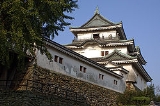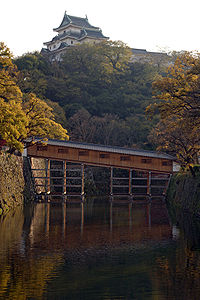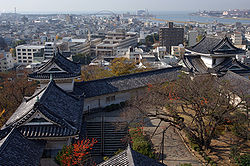
Wakayama Castle
Encyclopedia


Wakayama Prefecture
is a prefecture of Japan located on the Kii Peninsula in the Kansai region on Honshū island. The capital is the city of Wakayama.- History :Present-day Wakayama is mostly the western part of the province of Kii.- 1953 Wakayama Prefecture flood disaster :...
, Japan
Japan
Japan is an island nation in East Asia. Located in the Pacific Ocean, it lies to the east of the Sea of Japan, China, North Korea, South Korea and Russia, stretching from the Sea of Okhotsk in the north to the East China Sea and Taiwan in the south...
, sits at the mouth of the Kii River. Originally Ōta castle, home of the Saiga Ikki
Saiga Ikki
The , based in Ōta in Kii Province, were one of many Ikkō-ikki groups in feudal Japan.In particular, the members of the Saika Ikki, along with the monks of the Negoro-ji, were renowned for their expertise with the arquebus, and for their expert gunsmiths and foundries...
, it was captured by Toyotomi Hideyoshi
Toyotomi Hideyoshi
was a daimyo warrior, general and politician of the Sengoku period. He unified the political factions of Japan. He succeeded his former liege lord, Oda Nobunaga, and brought an end to the Sengoku period. The period of his rule is often called the Momoyama period, named after Hideyoshi's castle...
in 1585, during the Siege of Negoroji
Siege of Negoroji
The was commanded by Toyotomi Hideyoshi, a former vassal of Oda Nobunaga, who came to inherit his armies, his land, and his rivalry with the warrior monks of Japan when Nobunaga was killed in 1582. Thus, in a way this was the next in a series of many sieges that Oda Nobunaga's forces undertook in...
; many monks from Negoroji
Negoro-gumi
The ' were an order of warrior monks based in Negoroji temple, in Japan's Kii Province. They were famous for their skill with firearms, as well as with more traditional monk weapons like the naginata...
sought refuge in Ōta, which was soon destroyed by flood. Hideyoshi ordered the building of dams on three sides of the castle, focusing the rainwaters and diverting the river to ruin the castle. As hunger set in, the samurai, monks, and peasants inside Ōta surrendered, and fifty warrior monks
Sohei
were Buddhist warrior monks of feudal Japan. At certain points of history they held considerable power, obliging the imperial and military governments to collaborate....
led a final charge against Hideyoshi's army, committing honorable suicide.
Ōta was rebuilt as a temple for the Shinshu branch of Japanese Buddhism, severed from its history as a home to warrior monks. Wakayama Castle was then built on the same site, under the supervision of Toyotomi Hidenaga
Toyotomi Hidenaga
, formerly known as was a half-brother of Toyotomi Hideyoshi, one of the most powerful warlords of Japan's Sengoku period. He was also known by his court title, . After participating in and helping Hideyoshi win the battle at Kii, Hidenaga oversaw the construction of Wakayama Castle in 1585,...
, Hideyoshi's brother, with Tōdō Takatora
Todo Takatora
was a Japanese daimyo of the Azuchi-Momoyama period through Edo period. He rose from relatively humble origins as an ashigaru to become a daimyo...
's participation. Asano Yoshinaga arrived in 1600 to serve as feudal lord, under Tokugawa Ieyasu
Tokugawa Ieyasu
was the founder and first shogun of the Tokugawa shogunate of Japan , which ruled from the Battle of Sekigahara in 1600 until the Meiji Restoration in 1868. Ieyasu seized power in 1600, received appointment as shogun in 1603, abdicated from office in 1605, but...
. The castle was later attacked, in 1615, by forces loyal to Toyotomi Hideyori
Toyotomi Hideyori
was the son and designated successor of Toyotomi Hideyoshi, the general who first united all of Japan. His mother, Yodo-dono, was the niece of Oda Nobunaga....
, who were trying to end the siege of Osaka
Siege of Osaka
The was a series of battles undertaken by the Tokugawa shogunate against the Toyotomi clan, and ending in that clan's destruction. Divided into two stages , and lasting from 1614 to 1615, the siege put an end to the last major armed opposition to the shogunate's establishment...
.
In the summer of 1615, parts of the Osaka
Osaka Castle
is a Japanese castle in Chūō-ku, Osaka, Japan.Originally called Ozakajō, it is one of Japan's most famous castles, and played a major role in the unification of Japan during the sixteenth century of the Azuchi-Momoyama period.-Description:...
garrison left the city, ambushing various elements of the Tokugawa forces. Ono Harunaga
Ono Harunaga
was a general under Toyotomi Hideyori, and fought in the Siege of Osaka in 1615. He had become lord of Osaka castle after the battle of Sekigahara. Ono led forces against those of Wakayama Castle in the battle of Kashii and in the battle of Tennoji, where he was killed in...
, Hanawa Naoyuki and Okabe Noritsuna led part of the garrison in attacking Wakayama Castle, held by Asano Nagaakira
Asano Nagaakira
was a Japanese samurai of the early Edo period who served as daimyō of the Wakayama domain, and was later transferred to the Hiroshima Domain.Born Asano Iwamatsu, he was the son of Asano Nagamasa, who was a senior retainer of Toyotomi Hideyoshi. In 1594, Nagaakira was made a retainer of Toyotomi...
at the time. They had with them 3000 men, but the castle boasted 5000 in its garrison. Asano's men left the castle to meet the Western (Toyotomi) forces in what came to be known as the 'battle of Kashii
Battle of Kashii
The Battle of Kashii was the very first battle of the Summer Campaign of the 1615 Siege of Osaka. As the Shogun's Eastern Army prepared to renew the siege begun the previous winter, the Ōsaka garrison sallied forth, ambushing Tokugawa forces in a number of skirmishes and sieges...
.' Hanawa and Okabe were killed, and Ono was forced to flee back to Osaka.
The castle's current appearance is the result of renovations made by Tokugawa Yorinobu
Tokugawa Yorinobu
was a Japanese daimyo of the early Edo period.Born under the name Nagafukumaru, he was the 10th son of Tokugawa Ieyasu, by his concubine Oman-no-kata. On December 8, 1603, Yorinobu received the fief of Mito, then rated at 200,000 koku, as his fief. Mito had formerly belonged to his older brother,...
, tenth son of Tokugawa Ieyasu
Tokugawa Ieyasu
was the founder and first shogun of the Tokugawa shogunate of Japan , which ruled from the Battle of Sekigahara in 1600 until the Meiji Restoration in 1868. Ieyasu seized power in 1600, received appointment as shogun in 1603, abdicated from office in 1605, but...
, in the early 17th century.
At the end of the Edo period
Edo period
The , or , is a division of Japanese history which was ruled by the shoguns of the Tokugawa family, running from 1603 to 1868. The political entity of this period was the Tokugawa shogunate....
, in 1867, the feudal structure fell apart, and Wakayama Castle was opened to the public for the first time.
The castle was destroyed by Allied bombing during World War II
World War II
World War II, or the Second World War , was a global conflict lasting from 1939 to 1945, involving most of the world's nations—including all of the great powers—eventually forming two opposing military alliances: the Allies and the Axis...
, but was rebuilt in 1958 out of concrete and is open to the public as a symbol of the city and historical site.

